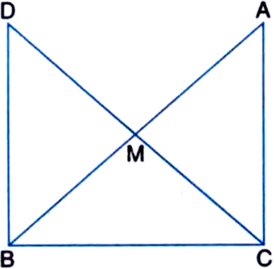 Short Answer Type
Short Answer Type

(i) ∆ABD ≅ ∆BAC
(ii) BD = AC
(iii) ∠ABD = ∠BAC.


Line I is the bisector of an angle ∠A and B is any point on I. BP and BQ are perpendiculars from B to the arms of ∠A (see figure). Show that:
(i) ∆APB ≅ ∆AQB
(ii) BP = BQ or B is equidistant from the arms of ∠A.
(i) ∆DAP ≅ ∆EBP
(ii) AD = BE.

 Long Answer Type
Long Answer Type
(i) ∆AMC ≅ ∆BMD
(ii) ∠DBC is a right angle
(iii) ∆DBC ≅ ∆ACB![]()
Given: In right triangle ABC, right angled at C, M is the mid-point of hypotenuse AB. C is joined to M and produced to a point D such that DM = CM. Point D is joined to point B.
To Prove: (i) ∆AMC ≅ ∆BMD
(ii) ∠DBC is a right angle
(iii) ∠DBC ≅ ∆ACB![]()
(i) In ∆AMC and ∆BMD,
AM = BM
| ∵ M is the mid-point of the hypotenuse AB
CM = DM | Given
∠AMC = ∠BMD
| Vertically Opposite Angles
∴ ∆AMC ≅ ∆BMD. | SAS Rule
(ii) ∵ ∆AMC ≅ ∆BMD
| From (i) above
∠ACM = ∠BDM | C.P.C.T.
But these are alternate interior angles and they are equal
∴ AC || BD
Now, AC || BD and a transversal BC intersects them
∴ ∠DBC + ∠ACB = 180°
| ∵ The sum of the consecutive interior angles on the same side of a transversal is
180°
⇒ ∠DBC + 90° = 180°
| ∵ ∠ACB = 90° (given)
⇒ ∠DBC = 180° - 90° = 90°
⇒ ∠DBC is a right angle.
(iii) In ∆DBC and ∆ACB,
∠DBC = ∠ACB (each = 90°)
| Proved in (ii) above
BC = CB | Common
∵ ∆AMC ≅ ∆BMD | Proved in (i) above
∴ AC = BD | C.P.C.T.
∴ ∆DBC ≅ ∆ACB. | SAS Rule
(iv) ∵ ∆DBC ≅ ∆ACB
| Proved in (iii) above
∴ DC = AB | C.P.C.T.![]() 2CM = AB
2CM = AB
![]()
![]()
 Short Answer Type
Short Answer Type
